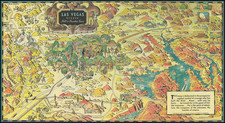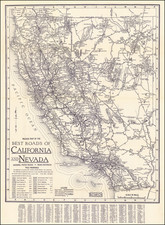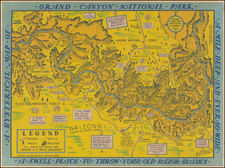Rare edition of Colton's map of the Southwest, issued in the 1861 edition of Colton's Atlas of the World.
Colton's map of the Southwest was first issued in 1855, showing only Utah & New Mexico Territories. Over the next 10 years, a number of variant editions were issued, including 3 editions naming Colona. This is a rare late edition of the map, showing Colorado, Nevada and Arizona. Nevada is in its truncated configuration, with the eastern border west of its final location. In the 1861 edition, a number of counties traverse all of Nevada, Utah and part of Colorado, extending to the Rockies.
The best map of the American Southwest to appear in Civil War period atlas. Rare variant.
States of the Map
Twelve states of the map were published. These include:
- State 1: 1855. Publishers not mentioned in title block.
- State 2: 1855-1856. By J. H. Colton 7 Co. NO. 172 William St. New York. 31° W, above neatline: Mexico.
- State 3: 1856. By J. H. Colton 7 Co. NO. 172 William St. New York. 31° W, above neatline: Chihuahua.
- State 4: 1857-1858. Plate number 53 (most other states is 51). Otherwise the same as State 3.
- State 5: 1859. By J. H. Colton 7 Co. NO. 172 William St. New York. 31° W, above neatline: Chihuahua. Arizona introduced in faint block letters at 33° N.
- State 6: 1859. By Johnson & Browning, 172 William St. New York. Bright red horizontal line at 34° showing a potential New Mexico/Arizona division.
- State 7: 1859-1860. By J. H. Colton 7 Co. NO. 172 William St. New York. Bright red horizontal line near 34° showing a potential New Mexico/Arizona division. Shows Colona.
- State 8: 1860. By Johnson & Browning, 172 William St. New York. Colona inserted arcing through eastern Colorado.
- State 9: 1860. Identical to State 7, but with Denver City shown.
- State 10: 1861-1862. Title changed to include Arizona, Colorado, and Nevada. Arcing "Colorado" and "Nevada" placed.
- State 10: 1862. Title changed to include Arizona, Colorado, and Nevada. Colorado and Nevada separate, no counties.
- State 10: 1863. Title changed to include Arizona, Colorado, and Nevada. Arizona and New Mexico have near modern boundaries. Plate number 67 (most other states is 51).
G. W. & C. B. Colton was a prominent family firm of mapmakers who were leaders in the American map trade in the nineteenth century. Its founder, Joseph Hutchins Colton (1800-1893), was a Massachusetts native. Colton did not start in the map trade; rather, he worked in a general store from 1816 to 1829 and then as a night clerk at the United States Post Office in Hartford, Connecticut. By 1830, he was in New York City, where he set up his publishing business a year later.
The first printed item with his imprint is dated 1833, a reprint of S. Stiles & Company’s edition of David Burr’s map of the state of New York. He also printed John Disturnell’s map of New York City in 1833. Colton’s next cartographic venture was in 1835, when he acquired the rights to John Farmer’s seminal maps of Michigan and Wisconsin. Another early and important Colton work is his Topographical Map of the City and County of New York and the Adjacent Country (1836). In 1839, Colton began issuing the Western Tourist and Emigrant’s Guide, which was originally issued by J. Calvin Smith.
During this first decade, Colton did not have a resident map engraver; he relied upon copyrights purchased from other map makers, most often S. Stiles & Company, and later Stiles, Sherman & Smith. Smith was a charter member of the American Geographical and Statistical Society, as was John Disturnell. This connection would bear fruit for Colton during the early period in his career, helping him to acquire the rights to several important maps. By 1850, the Colton firm was one of the primary publishers of guidebooks and immigrant and railroad maps, known for the high-quality steel plate engravings with decorative borders and hand watercolors.
In 1846, Colton published Colton’s Map of the United States of America, British Possessions . . . his first venture into the wall map business. This work would be issued until 1884 and was the first of several successful wall maps issued by the firm, including collaborative works with D.G. Johnson. From the 1840s to 1855, the firm focused on the production of railroad maps. Later, it published a number of Civil War maps.
In 1855, Colton finally issued his first atlas, Colton’s Atlas of the World, issued in two volumes in 1855 and 1856. In 1857 the work was reduced to a single volume under the title of Colton’s General Atlas, which was published in largely the same format until 1888. It is in this work that George Woolworth (G. W.) Colton’s name appears for the first time.
Born in 1827 and lacking formal training as a mapmaker, G. W. joined his father’s business and would later help it to thrive. His brother Charles B. (C. B.) Colton would also join the firm. Beginning in 1859, the General Atlas gives credit to Johnson & Browning, a credit which disappears after 1860, when Johnson & Browning launched their own atlas venture, Johnson’s New Illustrated (Steel Plate) Family Atlas, which bears Colton’s name as the publisher in the 1860 and 1861 editions.
J.H. Colton also published a number of smaller atlases and school geographies, including his Atlas of America (1854-56), his Illustrated Cabinet Atlas (1859), Colton’s Condensed Cabinet Atlas of Descriptive Geography (1864) and Colton’s Quarto Atlas of the World (1865). From 1850 to the early 1890s, the firm also published several school atlases and pocket maps. The firm continued until the late 1890s, when it merged with a competitor and then ceased to trade under the name Colton.









![Location Map Mesa Verde National Park and the Scenic Southern Highways Across the Rockies [on sheet with:] Pictorial Guide to the Center of Activities in Mesa Verde](https://storage.googleapis.com/raremaps/img/small/93996.jpg)



![Nouvelle Carte Du Mexique, Du Texas Et D'Une Partie Des Etats Limitrophes . . . 1840 [Proposed Railroads In Texas -- First Appearance of Arizona on a Printed Map]](https://storage.googleapis.com/raremaps/img/small/103480.jpg)
![[ Highway Symbols! ] Automobile Road Map of California-Nevada Los Angeles and Vicinity Long Beach](https://storage.googleapis.com/raremaps/img/small/99652.jpg)